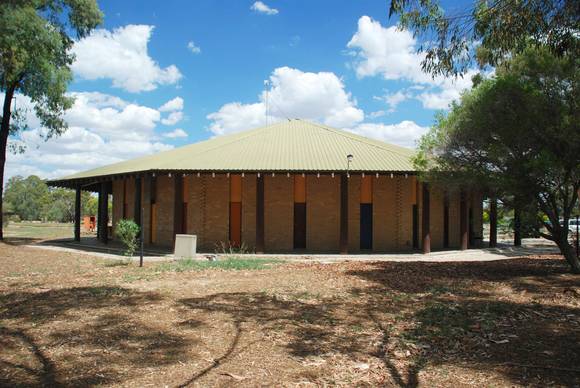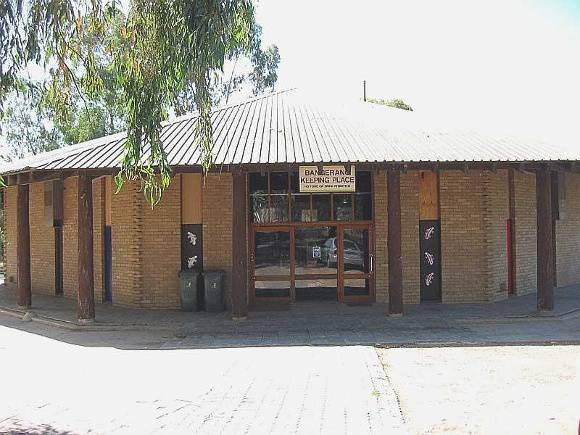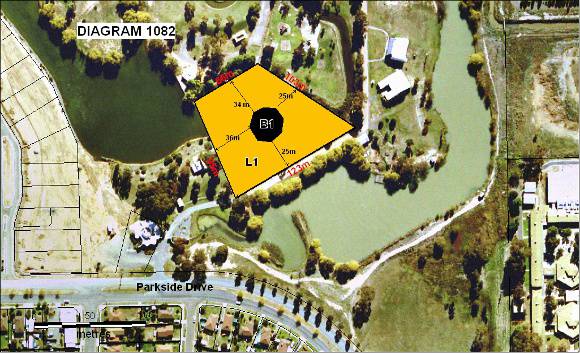| Back to search results » | Back to search page » |
|
BANGERANG CULTURAL CENTRE
Other NamesABORIGINAL KEEPING PLACE , BANGERANG KEEPING PLACE Location45 PARKSIDE DRIVE SHEPPARTON, GREATER SHEPPARTON CITY
File NumberPL-HE/03/0237 [ 1 - 2 ]LevelRegistered |
|
Statement of Significance
What is significant?
The Bangerang Cultural Centre, originally known as the Aboriginal
Keeping Place, was built as part of the International Village project
in Shepparton. First conceived in 1974, the Keeping Place was finally
opened in 1982 after many years of planning. The International Village
was set up in 1974 as a tourist attraction by the Shepparton Council
to celebrate the contributions of different ethnic groups. A space was
allocated to the local Aboriginal community for an arts and crafts
centre. The community, and in particular John (Sandy) Atkinson, OAM, a
leading figure in Aboriginal organisations, had a more imaginative
plan to set up their own museum or keeping place which would display
artefacts and provide a resource centre for educating people about the
cultural heritage of the Aboriginal people. The Aboriginal Arts Board
of the Australia Council, to which Sandy Atkinson was appointed in
1976, met with the local community with the result that the Shepparton
Aboriginal Arts Council Co-operative was set up with funding by the
Arts Board. The Co-operative, managed by Sandy Atkinson, spent many years
convincing organisations and individuals to commit to their visionary
plan. Shepparton Council set aside a grant of $70,000 and provided the
land on the site. Subsequently in July 1978 a deputation visited the
Premier of Victoria Rupert Hamer to seek a firm commitment to the
project by the State Government. The deputation headed by the leader
of the Country Party, Peter Ross Edwards, included the Chairman of the
Australia Council, Geoffrey Blainey; Sandy Atkinson; and the Mayor of
Shepparton, Murray Slee. As a result the Government allocated $170,000
towards the building. The Australia Council and the Aboriginal Arts
Board provided an additional $140,000. The innovative architect Robin Boyd (1919-1971) had designed a
circular interpretation centre at Tower Hill, Koroit in 1962, although
it was not completed until 1970. When Sandy Atkinson visited the
centre at the suggestion of Shepparton identity Mr Kilgour, he was
inspired to contact Boyd's partner Frederick Romberg who agreed to
design the building, with assistance from Ken Edelstein. The plans
were drawn up in 1979 and the successful tenderer was KG Renwick
Holdings Pty Ltd of Deniliquin. Sandy Atkinson saw the building as a circle, an important symbol in
Aboriginal culture. Romberg translated this idea into a brick
octagonal building originally with a wide cedar shingle roof lit by
skylights and surrounded by a timber colonnade. The windows are narrow
and full height. Internally the space is divided into eight bays
housing the four dioramas and other display areas. There is a
theatrette and a mezzanine level containing storerooms and office
space. Due to failure of the shingles, the original roof was replaced
by the Rotary Club with the existing metal sheet roof. The building was deliberately sited in a prominent position near the
entrance to the International Village and set in landscaped undulating
grounds partly encircled with water. A grassed amphitheatre was
established to stage cultural events. It was originally intended that
a bush garden would surround the building with edible fruits and
plants. Although this did not eventuate, cumbungi reeds (Typha
sp.) were planted along the waterways to provide the material for
spear making and basket weaving. The Centre, housing a range of cultural items from both the local
area and other parts of Australia, continues to run as a museum and
cultural centre operated by the Bangerang Cultural Centre Co-operative
Ltd.
How is it significant?
Bangerang Cultural Centre is of historical, social and architectural
significance to the State of Victoria.
Why is it significant?
Bangerang Cultural Centre is historically significant as an important
landmark in the struggle of the Aboriginal people to maintain their
own culture. As the first Aboriginal managed museum in Victoria to be
planned, the Centre is a tangible symbol of the shift of attitude in
society from the idea of assimilation to self-determination. The idea
for a Keeping Place was conceived in the early 1970s in a climate of
increasing consciousness of Aboriginal conditions and issues. In
Victoria a long campaign for community control at Lake Tyers Reserve
had resulted in the Aboriginal Lands Act 1971 which transferred land
deeds to the Lake Tyers and Framlingham communities. The Shepparton
Keeping Place was an early and innovative idea for a museum which
empowered Aboriginal people to interpret their own heritage for
indigenous and non-indigenous people. Bangerang Cultural Centre is historically significant for its
collection of four dioramas: Bogong Moths, River Economy, Mount
William Technology and Corroboree which feature life size figures
engaged in traditional aspects of Aboriginal life. The figures are
copies of the Museum of Victoria 19th century lifecasts made from
members of the Yarra tribe of Melbourne. The dioramas were the work of
Victorian artist George Browning (1918-2000), graduate of the National
Gallery of Victoria School and RMIT. As an official war artist
attached to the Military History Section in New Guinea and Borneo from
1943 to 1946, he not only produced a substantial collection of
paintings and drawings but after the war he also worked extensively on
the Australian War Memorial dioramas, as well as work for the Museum
of Victoria. Bangerang Cultural Centre is of social significance for the important
role it has played for many Aboriginal people in preserving their
identity and raising awareness of indigenous culture. It has assisted
in maintaining the cultural heritage of descendants of the Bangerang
people. The Bangerang tribe of Northern Victoria consisted of ten
different clan groups living in the region between the Murray and
Goulburn Rivers. Bangerang Cultural Centre is architecturally significant as a work of
renowned architect Frederick Romberg (1913-1992). Romberg was a
partner in the innovative firm of Grounds, Romberg and Boyd from 1953
to 1962; and later with Romberg and Boyd. In 1965 Romberg was
appointed Professor of Architecture at the University of Newcastle,
returning to Melbourne in 1975. The modest Keeping Place is perhaps
the most interesting work from the latter part of his career.
Architectural historian, Harriet Edquist has suggested that the
Keeping Place, designed after Boyd's death in 1971, could be Romberg's
homage to his partner. That such a ground-breaking architect as
Romberg was chosen for the Keeping Place project adds to our
appreciation of this place as an innovative project ahead of its time.
Group
Community Facilities
Category
Other - Community Facilities






